Floor heating convectors and their features
Most often, houses and apartments are heated with radiators, however, in our time there are many alternative options for heating appliances. These include floor heating convectors, which are no less effective and in some cases are a more expedient solution.
Next, we take a closer look at their features and device.
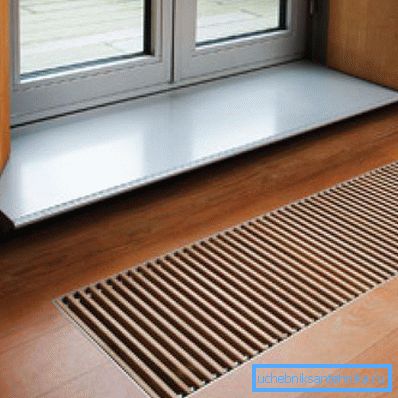
Features of heating with convectors
Heating with floor-mounted convectors is not new. In fact, these are the same batteries, only slightly modified, which are not mounted on the wall, but installed in the floor. Of course, the design of these products is different from traditional radiators, but the principle of operation is similar.
As a rule, these devices are used to heat rooms with non-standard parameters. For example, in recent times, panoramic glazing has become popular, especially in commercial organizations, offices and shops. Naturally, it is simply impossible to install standard radiators when the window starts from the floor itself.
Just in this case, heating convectors embedded in the floor are the solution. Moreover, they create a thermal curtain along the glass, and thereby prevent the penetration of cold into the room.
Note! As a rule, these heaters are installed not only along the windows, but also at the entrance to the room.
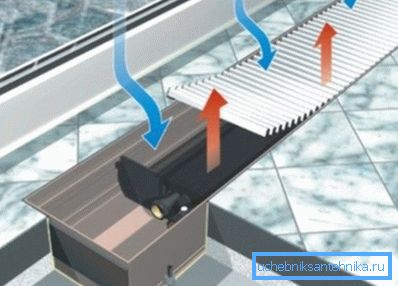
Merits
Since the devices under consideration resemble conventional radiators in construction, it is not worth waiting for them to be particularly economical or efficient.
Their advantages are located in a different plane:
- Hidden placement, thanks to which the construction can be installed in a room decorated absolutely in any style. You do not have to wrestle with how to disguise the heat source.
- Do not take away useful space indoors. Thanks to this, you can put the furniture close to the walls.
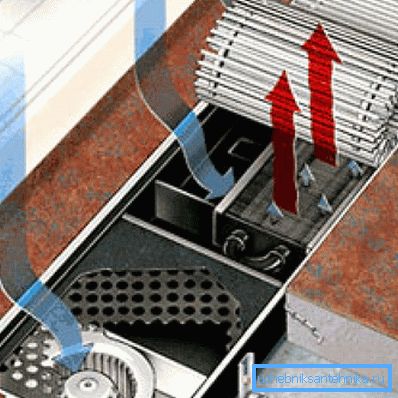
disadvantages
Along with the advantages, these heaters have some disadvantages:
- The efficiency is slightly lower than that of batteries installed on the wall, since part of the heat is necessarily absorbed by the floor. In addition, with this arrangement, convection of air is difficult, however, forced airflow eliminates this problem.
- It is much more difficult to install the device yourself, than to install conventional radiators.
- In apartment buildings, it is often impossible to install this structure at all, since it will not be possible to make niches in the floor slabs, and the ceiling height will not allow raising the floor.
- If water heating convectors are installed in the floor, then the floor must also be connected to them, which complicates access to communications in the future. After all, sooner or later, any systems fail.
Thus, it is not always advisable to equip the premises with these devices.

Device and species
These products look like a pencil case, which is covered with a decorative lattice. The heat exchanger is located inside the box. When installing such a device is entirely placed in a special niche.
Heat exchanger can be heated in two ways:
- Watery;
- Electric.
Below is a detailed look at the features of both types of devices.
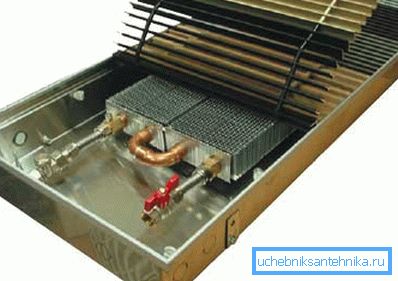
Water
Water devices can be made both in the case and without it. The latter are simply a heat exchanger with threads.
It should be noted that the device in the case is easier to install, since the box simply fits when the floor is filled. True, the price of the product in this case is higher. If the structure does not have a casing, then during installation it is necessary to think over the fastening of the heat exchanger, as well as to lay thermal insulation under it.
Note! To speed up space heating, some models of these devices are equipped with fans that blow a heat exchanger. True, such a heater is called a fan coil; however, sellers and manufacturers do not single them out into a separate category.
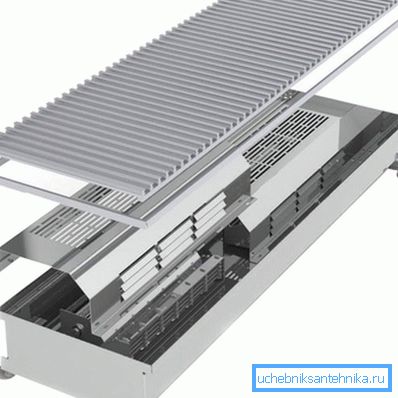
Electric
Convectors of this type are conventional electric heaters that are embedded in the floor. Their capacity can range from 750 to 3000 kW. Externally, these devices are not much different from the above.
Note! Often in catalogs electric convectors for heating are called water fankoyla. This is due to the fact that the latter are equipped with a fan that runs on electricity.
Electric heating devices are an excellent choice if the centralized heating system is not installed in the room and there is no possibility to place the heater elsewhere, for example, if the design of the room does not allow the heater to be visible. In addition, the installation instructions for such devices are simpler than connecting water heaters.
That's all the main features of floor convectors.
Conclusion
Floor-mounted heating convectors have many drawbacks. However, they are an excellent solution in the case when it is necessary to hide the heating devices or it is not possible to install them on the wall. Therefore, they are most often used in public institutions and private homes, but they are practically not found in apartments.
From the video in this article, you can pick up some additional information on this topic.